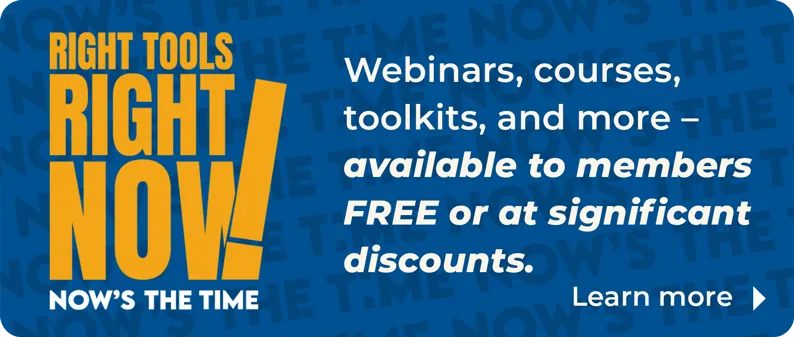Note: These additional FAQs supplement the full Core Standards FAQs available on www.nar.realtor and are incorporated into that document.
1.4. When must local and state associations comply with the Core Standards?
Beginning July 1, 2016 the compliance cycle was changed to the calendar year. The next compliance deadline is December 31, 2017, and will remain December 31 in subsequent years. (Revised 12.1.16)
1.5. What will the certification period be for subsequent years?
As noted at FAQ 1.4, beginning July 1, 2016, the Core Standards compliance cycle was transitioned to the calendar year. (Revised 12.1.16)
1.7. If the state association does not confirm our local association’s compliance with the Core Standards by December 31st is that determination subject to review by NAR? What is the process?
No association will lose its charter without first being given an opportunity to appear before a panel of at least five (5) members of the NAR Association Executives Committee to show cause why the association’s charter status should not be terminated. In such cases the recommendation of the panel will be reported to the NAR Board of Directors for final action. (Revised 12.1.16)
1.8. Must the activities mandated by the Core Standards begin and be completed during the same compliance cycle? Will consumer outreach efforts, for example, initiated before July 1, 2016 satisfy the Core Standards for the third compliance cycle?
As long as the activity continued into the current compliance cycle, the fact that it was "initiated" before the start of the cycle doesn't make it ineligible. (Added 8.7.14) (Revised 12.1.16)
1.9. Will the NAR Board of Directors vote on whether associations' charter will be revoked?
The charter revocation process will begin automatically after an association's compliance with the Core Standards isn't confirmed by the state association, and that determination is shared with NAR via the Compliance Tool. If an association appeals the state association's conclusion that the local association had not met the Core Standards the local association will have an opportunity to appear before a five (5) member panel of the NAR Association Executives Committee to show cause why the association's charter shouldn't be revoked. The panel's recommendation will be reported to the NAR Board of Directors for final action. If the Directors determine the charter should be revoked, the revocation will be effective immediately. Revocation of the charters of associations that don’t challenge the state association’s determination of non-compliance will also be acted on by the Board of Directors during the REALTORS® Legislative Meeting in May. (Revised 4.29.15 and 12.1.16)
1.9.1. If our association is not certified by the state association as compliant with the Core Standards, and if we don't elect to appeal the state association's determination, when would our charter as a Member Board be officially revoked?
Hopefully all associations will be able to achieve compliance with the Core Standards, either on their own or by working jointly with another association (see FAQ 2.6 for alternative methods of achieving compliance). That said, if your association is not certified by the state association, and if you don't elect to appeal the state association's determination, your charter would be revoked by the NAR Board of Directors during the REALTORS® Legislative Meeting in May each year. (Added 4.29.15) (Revised 12.1.16)
1.11. A member of one of our local associations is concerned that if she pays her dues to her local association and it is subsequently determined that association did not satisfy the Core Standards and its charter is revoked, she will have to join a different local association and pay dues again this year. I think she is hoping for a credit in the event this occurs.
First, the vast majority of associations meet the Core Standards each year.
Second, no association will lose a charter until the NAR Board of Directors acts in May each year.
Third, if an association were to lose its charter, its territory reverts to unassigned status. At that point members of the former association could choose to be direct members of the state association and NAR (assuming the state association accepts direct members).
Last, given the spirit of collegiality and cooperation that's a hallmark of REALTOR® associations, it's hoped other area associations would welcome those members, and make their transition as easy and economical as possible. And, it shouldn’t be overlooked that the state and national dues allocations would have already been paid, and only the local allocation would be in play at that point. (Added 4.29.15) (Revised 12.1.16)
2.4. What is the role of the state association in determining whether local associations meet the Core Standards?
Each year local associations will use the online compliance certification system ("Compliance Tool") to submit the required Core Standards information to the state association for review and validation. By January 30th each year, each state association, using the Compliance Tool, provides NAR with the names of their local associations compliant with the Core Standards. (Revised 1.12.16 and 12.1.16)
2.4.2.a. I'm the state AE. We're trying to help all of our local associations with the Core Standards but two of our local associations are missing from the Compliance Tool. They are listed accurately in the M1 database. Why don't they appear in the Compliance Tool?
They will appear in the Compliance Tool - once they begin using it. Local Associations do not appear in the Compliance Tool until they begin to complete the certification form (Compliance Tool). State associations may want to contact "missing" local associations and remind them about the annual December 31 deadline. (Added 3.9.15) (Revised 12.1.16)
2.7 Is there an ongoing professional development requirement for associations chief paid staff ?
Yes, each year the association’s chief paid staff officer must complete at least six (6) hours of REALTOR® association professional development. Training meeting the requirement is available annually at the NAR Association Executives Institute. Similar programs are available in many states. Receipt of the RCE designation is also deemed to satisfy the requirement – but only for the year in which it is received by the chief paid staff member.
It should also be noted that effective at the beginning of the third compliance cycle (July 1, 2016-December 31, 2017) this requirement applies even where an association has no paid staff. In associations with no paid or salaried staff, the individual (often an officer or director) primarily responsible for performing the functions ordinarily carried out by paid staff in other associations must complete at least six (6) hours of REALTOR® association professional development during each compliance cycle. (Added 7.3.14) Revised 12.1.16)
2.7.1 Our association is small but flourishing. We have no paid or salaried staff. Does the Core Standards professional development requirement for “chief paid staff” apply to us?
Yes. Starting with the third compliance cycle (July 1, 2016-December 31, 2017) the professional requirement was extended to apply to association with no paid staff. In those associations the individual (most often an officer or director) primarily responsible for performing the functions that would be carried out by paid staff in other associations must complete at least six (6) hours of REALTOR® association professional development during each compliance cycle. (Added 12.1.16)
2.10 Can state associations require local associations to submit their compliance information prior to December 31 each year?
Yes. State associations can set their own deadlines for their local associations to submit information demonstrating compliance with the Core Standards. Additionally, while the deadline for local associations to submit compliance information using the compliance database is December 31, state associations will have an additional 30 days (until January 30) to certify their local associations' compliance status to NAR. (Added 8.7.14) (Revised 12.1.16)
2.12. Must each of the 62 entries in the Compliance Tool be answered?
While many of the items in the Compliance Tool require a response, there are exceptions. For example, Section III, Consumer Outreach, includes twenty-eight examples of activities that would meet the Core Standards. As established in the Core Standards, every association needs to conduct at least four meaningful consumer engagement activities annually, including at least two activities demonstrating how the association is the “Voice for Real Estate in its market, and at least two activities demonstrating the association’s involvement and/or investment in the community.
- Being the “Voice for Real Estate” -‐ promoting market statistics and/or real estate trends and issues (e.g., release through press releases, interviews, etc. of MLS statistics, local market statistics, NAR research reports, local/state analysis of NAR statistics, etc.)
- Community involvement and investment -‐ promoting the value proposition of using a REALTOR® and/or engaging in community activities which enhance the image of the REALTOR®, such as organizing human resources (e.g. participating in a Habitat for Humanity build) or conducting fundraising activities to benefit local community or charitable organizations.
Additionally, activities not specifically described in the Compliance Tool can be reported in the Compliance Tool. An "Other" entry has been added to both of the subcategories under Consumer Outreach, and associations can explain how they've been the "Voice for Real Estate", and report other activities demonstrating the association's "Community Involvement and Investment. (Added 3.9.15) (Revised 12.1.16)
2.13. I'm the state association board services director and I'm responsible for confirming our local associations' compliance with the Core Standards. I understand why we can't review our local associations' strategic plans (we're considered to be competitors), but how do we confirm they have a compliant strategic plan?
All that's required is the state association review the certification information in the Compliance Tool to ensure the local association has certified that its strategic (or business) plan has actionable implementation strategies; that it was reviewed and discussed by the board of directors during the current compliance cycle, including the date of the review and discussion; and that the date NAR approved the plan is shown. (Added 4.6.15) (Revised 12.1.16)
3.1. What financial and other resources are or will be available from NAR to facilitate mergers?
Grants at a minimum of $15,000 and a maximum of $25,000 will continue to be available to merged associations until June 30, 2016. Grant amount are calculated at $25 times the number of primary REALTOR® members in the newly-merged association but in no case will exceed $25,000. The merger grants are available for two years because in some cases merger discussions may not start until after the associations first attempt to meet the Core Standards on their own; also because merger negotiations can take considerable time to complete.
Special Supplemental Note to FAQ 3.1 – December, 2016
At the 2016 REALTORS Legislative Meeting, the NAR Finance Committee extended the availability of merger grants to the third compliance cycle (July 1, 2016 – December 31, 2017) with the caveat that the extension be limited to 25 additional grants with the total funding limited to $625,000. (Added 12.1.16)
Special Supplemental Note to FAQ 3.1 - October 29, 2014
In order to provide a greater level of support to the local association community as they consider mergers to better serve members and achieve compliance with the Core Standards, the NAR Finance Committee has expanded eligibility for merger grants as follows:
The initial merger grant process, as outlined above, will continue. Initial mergers will be funded at $25 per member in the resulting merged association, with the minimum grant remaining $15,000 and the maximum grant also remaining $25,000. As initially approved and published, only one grant of not more than $25,000 was available to any merged association; any subsequent additional merger activity involving that association was not eligible for a further merger grant.
Effective immediately, funding for subsequent or "second generation" merger grants are available at the same rate of $25 per member, up to a maximum of $25,000 for an additional merger, but will be computed only on any incremental gain in membership to the final merged organization. The calculation of such grants will not include members who were included in the calculation of another merger grant. These supplemental merger funds will be available through the end of merger grant period, June 30, 2016.
Example: If an association that has 2,000 primary REALTOR® members merges with an association with 500 primary REALTOR® members (the "first merger"), the resulting entity would be eligible for a grant of $25,000. If that newly-merged association is later involved in a subsequent merger under which the previously-merged 2,500-member association now merges with a different 500-member association, an additional grant of $12,500 (500 additional members times $25 = $12,500) will be available. The additional grant (based on the second merger) cannot include the first 2,500 members (the total as a result of the first merger) because they were previously included in an earlier grant calculation. Only the additional incremental primary REALTOR® members added as a result of the second merger can be considered in this next grant calculation.
A comprehensive NAR Merger Kit and the white paper An Alternative to Merging are available . (Revised 1.12.16)
4.1. Do the Core Standards require associations to have a strategic plan? And what’s required during each compliance cycle?
Yes, every local and state association must have a strategic (or business) plan and must annually certify that its board of directors has reviewed and discussed the plan. Associations must also annually certify that their strategic (or business) plan includes an advocacy component, a consumer outreach component, and actionable implementation strategies. (Revised 12.1.16)
4.2. (Deleted 12.1.16)
4.2.1 (Deleted 12.1.16)
4.3. (Deleted 12.1.16)
4.3.1 (Deleted 12.1.16)
4.3.2 (Deleted 12.1.16)
4.7. (Deleted 12.1.16)
4.8. (Deleted 12.1.16)
4.9. What must our strategic plan include to meet the Core Standards?
Every local and state association must annually certify that their strategic or business plan includes an advocacy component, a consumer outreach component, and actionable implementation strategies. Each year every association must also certify that its board of directors has reviewed and discussed the plan. (Revised 7.3.14 and 12.1.16)
4.10. (Deleted 12.1.16)
4.12. Our association has strong, collegial relationship with the state association. However, we are also competitors when it comes to offering certain products, services and benefits to members. Our plans for new offerings are incorporated in our strategic plan or, in some cases in our business plan. We do not want to share that information with the state association or with other competitors. Do the Core Standards require us to make these plans available to the state association?
The short answer is no. Strategic and/or business plans will not be made available to the state association or to any other association in your state. (Revised 9.26.14 and 12.1.16)
4.13. (Deleted 12.1.16)
4.13.1. Our association’s strategic plan was approved by NAR in early 2015 in connection with the first (2014-15) compliance cycle. Do we need to resubmit our strategic plan every year going forward to comply with the Core Standards?
Only changes to your plan’s Advocacy and Consumer Outreach components need to be submitted to NAR for review at csgrantrequest@realtors.org . (Added 10.15.15) Revised 12.1.16)
4.14. Because local associations' strategic plans can't be viewed by other associations (including state associations), how will the state associations know the strategic plans of their local associations have been approved by NAR?
A field has been added to the Compliance Tool for local associations to include the date of approval by NAR. (Added 3.9.15)
5.2 (Deleted 12.1.16)
5.3 (Deleted 12.1.16)
5.3.1. Is receiving an advocacy-related grant an activity demonstrating compliance with the Core Standards?
Simply applying for and receiving an advocacy-related grant from NAR is not sufficient to meet the Core Standards. Rather, the initiative or activity for which the funds were intended for must be conducted. (Added 12.1.16)
5.5.6. (Deleted 12.1.16)
5.5.9. Can contributions invested via dues billing that are mandatory assessments, where state law permits such assessments, count towards RPAC Participation?
To count towards RPAC Participation via NAR's recognition program, investments must be voluntary, and the minimum amount is $15. (Added 12.24.14) (Revised 12.1.16)
5.7. (Deleted 12.1.16)
5.9.1. Several months ago we emailed (or thought we emailed) a Call for Action to our REALTOR® members. We just learned that due to a technical glitch, the email was never sent. The issue discussed in the Call for Action was decided more than a month ago, so there's no point to sending it now. If neither our state association or NAR issues another Call for Action between now and December 31st, will our charter be revoked?
It's been anticipated since the start of the Organizational Alignment/Core Standards initiative, that the compliance criteria would be applied reasonably and with flexibility. In your circumstances, it's clear your association made a good faith effort to communicate the Call for Action that failed due to an email glitch. You will want to explain to the state association what happened, and what other efforts e.g., publication of the Call for Action on the association's website, in the online newsletter, etc., had been made. An association should not be in the position of losing their charter - or having to defend their charter - because of a computer glitch. (Added 4.6.15) (Revised 12.1.16)
5.11. Our Association has a number of REALTOR® members who have been active participants in the Broker Involvement Program for several years. Would attaching that roster to the Compliance Tool demonstrate "advocacy engagement"?
If your association has actively recruited members during the current compliance cycle, those recruitment efforts would demonstrate engagement - for the current cycle . Examples of engagement include, but aren’t limited to, conducting outreach programs/efforts to recruit new participants, encouraging brokers to sign up at membership meetings, sending recruitment emails to members, or hosting functions specifically focused on Broker Involvement Program recruitment. (Added 4.6.15) (Revised 12.1.16)
5.12. Has the Advocacy component of the Core Standards been changed from what was required during the first two compliance cycles?
Yes, comprehensive enhancements to the Advocacy component were adopted in May, 2016 effective with the third (July 1, 2016 – December 31, 2017) and future compliance cycles. In addition to the existing requirements related to RPAC solicitations on dues billings communicating the value of RPAC, and Calls for Action, local and state associations must also support the REALTOR Party “Vote, Act, Invest” goals by conducting six initiatives/ activities with at least two activities/initiatives supporting each of the goals. Examples of acceptable activities/initiatives for each goal are listed in the online Compliance Tool. Please note that these are not the only activities or initiatives that will meet the requirement, and that each goal has an “Other” entry where explanations and/or examples can be included. (Added 12.1.16)
5.13. In the Compliance Tool under Advocacy, both the “Vote” and the “Act” goals show Independent Expenditures and Issues Mobilization campaigns will meet the Core Standards. What are they and how are they different?
Put simply, an independent expenditure is a political campaign communication that expressly advocates for the election of a clearly identified candidate. The communication is not made in cooperation with, in consultation with, or in concert with or at the request or suggestion of a candidate, the candidate’s authorized committee, or the candidate’s political party.
On the other hand, an issues mobilization campaign is a political campaign communication that expressly advocates for the passage or defeat of a clearly identified legislative issue, regulatory action, or ballot initiative. (Added 12.1.16)
5.14. Can you explain what a legislative or advocacy outreach operation is?
A legislative or advocacy outreach operation is any activity in which the association educates or engages REALTORS® on legislative priorities important to the association. For purposes of the Core Standards, qualifying activities could include specifically asking your REALTOR® members to take action to educate lawmakers on your association’s positions regarding legislation or real estate issues. (Added 12.1.16)
5.15. Our association used an Issues Mobilization grant from NAR to conduct two separate (but related) activities. Can both of the activities be used to demonstrate compliance with the Advocacy requirement of the Core Standards?
The answer to your question will depend on whether there were really two separate (albeit related) activities. For example, an association could use part of the grant to conduct public polling to gauge public support for repeal of a sign ordinance. Assuming the poll showed significant public support for the association’s position, the association could use the balance of the grant to mail postcards to voters encouraging them to contact their elected officials to urge repeal. In a case like this, both activities would demonstrate compliance with the Core Standards (i.e. count as two compliance activities). (Added 12.1.16)
5.16. If our association contributes Issues Mobilization monies to support a campaign being conducted by a neighboring association, would this be a Core Standards “Invest” qualifying activity?
Simply writing a check or otherwise making funds available to another association that is conducting an Issues Mobilization Activity would not be considered a qualifying “Invest” activity. (Added 12.1.16)
6.1. What do the Core Standards require with respect to new and continuing member training?
The Core Standards require associations to provide new and continuing member Code of Ethics training as required by Professional Standards Policy Statements #47 and #48. Those Policy Statements discuss the various ways associations can satisfy the duty to provide Code of Ethics training.
Professional Standards Policy Statement #47, New Member Orientation, provides:
Effective January 1, 2001, applicants for REALTOR® membership shall complete an orientation program on the Code of Ethics of not less than two (2) hours and thirty (30) minutes of instructional time. This requirement can be satisfied through instruction provided by the local Board or by another Board and can include classroom instruction, home study, correspondence study, or Internet-based instruction. Any orientation program must meet the learning objectives and minimum criteria established by the National Association of REALTORS® from time to time. REALTORS® who having completed such orientation shall not be required to complete further Code of Ethics orientation upon application for membership in another Board provided that REALTOR® membership has been continuous or that any break in membership is for one (1) year or less.
Professional Standards Policy Statement #48, REALTORS®ʼ Code of Ethics Training, provides in relevant part:
Beginning January 1, 2017 through December 31, 2018, and for successive two (2) year periods thereafter, Realtors® are required to complete biennial ethics training of not less than two (2) hours and thirty (30) minutes of instructional time. Realtors® completing such training during any two (2) year cycle shall not be required to complete additional ethics training in respect of this requirement as a requirement of membership in any other Board or Association.
A Realtor® completing the new member Code of Ethics orientation during any two (2) year cycle shall not be required to complete additional ethics training in respect of this requirement until a new two (2) year cycle commences.
Failure to complete the required periodic ethics training shall be considered a violation of a membership duty.
Failure to meet the requirement will result in suspension of membership for the first two months (January and February) of the year following the end of any two (2) year cycle or until the requirement is met, whichever occurs sooner. On March 1 of that year, the membership of a member who is still suspended as of that date will be automatically terminated.
Every Board and Association is required to provide access to necessary ethics training programs either locally, in conjunction with other Boards and Associations, or through other methods (including, but not limited to, home study, correspondence courses, or Internet-based instruction). Any training offered pursuant to this requirement must meet the learning objectives and minimum criteria established by the National Association of Realtors® from time to time.
(Revised 12.1.16)
6.3. Has NAR developed alternative "expedited" Code of Ethics enforcement procedures?
The original "expedited" procedures for enforcement of the Code of Ethics remain available at Section 20 (f-q) in the NAR Code of Ethics Arbitration Manual.
Additionally, at the 2014 REALTORS® Conference & Expo (November 2014), the Professional Standards Committee recommended, and the Board of Directors approved, several new and enhanced enforcement tools. These include:
- Clarification of the existing procedures (including timeframes)
- An alternative "fast track" hearing process which can be adopted at associations' discretion
- A model "citation" policy (including a schedule of fines for eligible citations) which can be adopted at associations' discretion
- Increased use of "remote" testimony
- Enhanced ombudsman procedures and mandatory provision of ombudsman services in 2016
- Enhanced information about the appropriate use of "alternate" panel members
- Restrictions on the availability of continuances
This information and materials can be found in the Code of Ethics and Arbitration Manual except for the fast track hearing process and the model citation policy. Information about those processes can be found at http://www.nar.realtor/policy/fast-track-supplement-to-ceam and at http://www.nar.realtor/policy/nar-model-citation-policy-and-schedule-of-fines. (Revised 12.10.14 and 12.1.16)
6.4. (Deleted 12.1.16)
6.7. Is there an NAR model "citation system?"
Information about the model citation system can be found at http://www.nar.realtor/policy/nar-model-citation-policy-and-schedule-of-fines. (Revised 12.15.14 and 12.1.16)
6.11. Must our association's website include information available to members and the public about professional standards policies and procedures?
Association websites must link to the Code of Ethics and professional standards resources available from NAR, and from the state association if available. A link to the NAR resources can be found in Section I of the online Compliance Tool, Additionally, NAR's Member Experience staff has created a comprehensive compendium of information that includes the Code of Ethics, explanatory whitepapers (e.g. Before You File an Ethics Complaint, the Sanctioning Guidelines, and others), standard forms for filing and processing ethics complaints and arbitration requests, the Statements of Professional Standards Policy adopted by the NAR Board of Directors, as well as resources for professional standards administrators. These materials can also be found at www.nar.realtor . (Added 4.29.15) (Revised 12.1.16)
7.1. Where can I find examples of association consumer outreach initiatives?
Examples of how your association can be the “Voice for Real Estate” and qualifying “Community Involvement and Investment” activities can be found in Section III of the online Compliance Tool. Additionally, an “Other” entry has been added to both of the Consumer Outreach subcategories so associations can explain how they’ve been the “Voice for Real Estate” in their community, and can report other activities/initiatives demonstrating their “Community Involvement and Investment”. Both permit examples to be attached. “Consumer Outreach Best Practices are available at http://www.nar.realtor/ae/manage-your-association/consumer-outreach-best... (Revised 12.1.16)
7.2. Some of our association’s “Community Involvement and Investment” activities are organized and conducted by our association’s wholly-owned subsidiary Foundation. Do activities satisfy the Core Standards if they’re conducted by our REALTOR® Foundation?
Yes. (Added 10.24.14) (Revised 12.1.16)
7.3. Are NAR grants available that can be used to meet the "Consumer Outreach" and the Advocacy Core Standards?
Diversity, Housing Opportunity, Placemaking and Smart Growth grants are available to fund Community Involvement and Investment, and Advocacy activities. http://www.realtoractioncenter.com/for-associations/community-outreach/ (Added 3.9.15) (Revised 12.1.16)
7.4. (Deleted 12.1.16)
7.5. Our association conducted an activity we believe shows how we're the Voice for Real Estate locally, but the activity isn’t listed among the examples shown in the Compliance Tool. Can we still use that activity to demonstrate compliance with the Core Standards? And shouldn't that be true for the Community Involvement and Investment subcategory?
Yes. The suggested activities shown in the Compliance Tool are intended as examples of activities that would that will satisfy the Core Standards, not as an exclusive list of compliant activities. , And, as mentioned in Question 7.1, an “Other” entry has been added to both of the Consumer Outreach subcategories so associations can explain how they’ve been the “Voice for Real Estate” in their community, and can report other activities/initiatives demonstrating their “Community Involvement and Investment”, and both subcategories permit examples demonstrating compliance to be attached. (Added 3.9.15) (Revised 12.1.16)
7.6. If our association makes a financial donation to a local charity from our general funds, would that be an "activity" demonstrating "Community Involvement and Investment" under the "Consumer Outreach" Core Standard?
No. This section of the Core Standards contemplates associations conducting actual activities such as those offered as examples in the Compliance Tool. Simply writing a check, without there being any actual member involvement in an association-conducted activity, while commendable, would not meet the requirement. (Added 4.6.15) (Revised 12.1.16)
7.7. If we conduct two different fundraisers for two different charities at two different times of the year, can we use both to demonstrate compliance with the "Community Involvement and Investment" requirement under "Consumer Outreach"?
Yes, but keep in mind that the association will also need to conduct at least two demonstrating how it’s been the “Voice for Real Estate”. (Added 4.6.15) (Revised 12.1.16)
8.2. (Deleted 12.1.16)
8.3. What training for local and state association chief staff (and in associations with no paid staff, by the individual primarily responsible for performing the functions ordinarily carried out by paid staff) satisfies the Core Standards requirements?
As noted in Question 2.8:
While attendance at in-person educational programs like the NAR AE Institute and similar programs conducted by state associations is an optimum learning experience because of the opportunity to interact with peers face-to-face, it should also be considered that much of the educational offerings available to REALTORS® from NAR (including REALTOR® University) and its Institutes, Societies and Councils is delivered online. What's important here is that the program addresses management/administration of real estate associations. Where a question arises about the relevancy of programming offered in satisfaction of this requirement, the state association could require documentation or explanation of how the course related to real estate association management. Given the broad experience and skillsets required of association executives, it's anticipated this requirement will be construed liberally.
(Revised 8.7.14 and 12.1.16)
8.7. Section IV - Unification Efforts and Support for the REALTOR® Organization asks for the date of last approval of our association bylaws, MLS rules and MLS Bylaws (if the MLS is incorporated). We submit those documents to NAR periodically, but often at different times. As a result, the approval dates vary. What do we do if we have two or more approval dates to report?
The online Compliance Tool has separate fields for associations to use to report the last approval date for association bylaws, MLS rules and MLS bylaws . If the MLS is a committee of the association, simply leave the date of approval for MLS bylaws blank. (Added 3.9.15) (Revised 12.1.16)
8.8. Where do we send our governing documents i.e., association bylaws, MLS rules, and MLS bylaws (our MLS is a wholly-owned subsidiary of the association) for review and approval by NAR?
Please send governing documents by email to member_policy@realtors.org. Information on the governing document review process can be found at http://www.nar.realtor/policy/association-governing-document-review-process.
Note: Associations that are shareholders in a regional MLS, and that have adopted a common set of MLS bylaws and/or rules, do not need to submit those documents to NAR if they have already been submitted for review by the regional MLS. (Added 4.6.15) (Revised 12.1.16)
8.9. (Deleted 12.1.16)
8.11. Do the Core Standards require associations to have a strategic plan?
Yes, as discussed in Question 4.1, every local and state association must have a strategic (or business) plan, and must annually certify that its board of directors has reviewed and discussed the plan. Associations must also annually certify that their strategic (or business) plan includes an advocacy component, a consumer outreach component, and actionable implementation strategies. (Added 12.1.16)
8.12. Recently added Core Standard IV.I. requires associations to offer, promote or provide at least one professional development opportunity for the general membership during each compliance cycle. Do we have to actually conduct classroom training to comply with the new requirement? And does “professional development” mean training?
Professional development includes training and other methods to help members develop or enhance real estate–related skills. The Core Standard doesn’t require associations to actually conduct – or even sponsor classroom training. The requirement can be met by something as simple as pointing members via email or the association website to reasonably available classroom and online programs, tools and resources available from NAR, from the state association, from NAR’s Institutes, Societies and Councils and their state and local chapters, or from other sources and providers. (Added 12.1.16)
8.13. What resources are available to meet the Core Standards “REALTOR® Safety” requirement?
This Core Standard requires associations to annually certify that they’ve conducted - or promoted - a REALTOR® safety activity. Comprehensive REALTOR® Safety information and resources are available at http://www.nar.realtor/topics/realtor-safety and at http://www.nar.realtor/field-guides/field-guide-to-realtor-safety. The online Compliance Tool asks associations to explain or describe the REALTOR® safety activity they’ve conducted or, alternatively - promoted during the current compliance cycle. (Added 12.1.16)
8.14. The Core Standards now require local and state associations to annually provide resources for or access to leadership development education and/or training for elected REALTOR® leaders, and to document the training, tools programs they offer or provide access to. Does this mean that all of our officers and directors must complete annual leadership training to meet the Core Standards? What if my president won’t participate?
This Core Standard requires associations to provide resources and/or access to training for REALTOR® leaders. At a minimum this includes the president and president-elect, though many associations will make leadership development opportunities more widely available. Please note nothing in the Standard requires REALTOR® leaders to take advantage of opportunities made available by the association (though hopefully many will). And, association won’t lose their charters because the president didn’t choose to enhance her or his leadership skills.
8.15. What kind of leadership development “resources” must our association provide for our REALTOR leaders?
“Resources”, as used in the Core Standard, means educational resources, not financial resources. It’s expected associations will identify leadership development opportunities their elected leaders can pursue, not that associations would pay, for example, for a degree in organizational development. If an association provided its leaders with information about programs like the NAR Leadership Summit, the state association’s leadership training, or similar leadership development/education opportunities that are reasonably accessible to those leaders, that would meet the Core Standard. There will likely be many other classroom and on-line leadership development/training opportunities associations can make their leaders aware of to meet this requirement. (Added 12.1.16)
8.16. Recently added Core Standard IV.I. requires associations to offer, promote or provide at least one professional development opportunity for the general membership during each compliance cycle. Do we have to actually conduct classroom training to comply with the new requirement? And does “professional development” mean training?
Professional development includes training and other methods to help members develop or enhance real estate–related skills. The Core Standard doesn’t require associations to actually conduct – or even sponsor classroom training. The requirement can be met by something as simple as pointing members via email or the association website to reasonably available classroom and online programs, tools and resources available from NAR, from the state association, from NAR’s Institutes, Societies and Councils and their state and local chapters, or from other sources and providers. (Added 12.1.16)
8.17. Are there resources available from NAR for our association to use in conducting the required annual performance for our chief staff?
A CEO review toolkit, including sample forms contributed by local and state associations is available at http://www.nar.realtor/ae/manage-your-association/human-resources-toolkit/chief-staff-performance-evaluation. (Added 12.1.16)
8.18. Our association has no paid staff. Are we required to conduct an annual performance appraisal for the member who’s primarily responsible for performing the functions ordinarily carried out by paid staff in larger associations?
No. The annual performance appraisal requirement applies only to associations with paid staff. (Added 12.1.16)
8.19. Our association contracts with a neighboring association for management services. Must we conduct a performance appraisal for that association’s chief staff member?
No. The responsibility for conducting the performance appraisal is with the association that employs the chief staff member. (Added 12.1.16)
8.20. Our association and two others jointly contract with the same association executive for association management services. In other words, we “share” the same association executive. Must each association annually conduct a performance review for that AE?
No, that isn’t required under the Core Standards, though each association could conduct separate performance reviews if they choose. What’s important is that the association executive receive an annual performance review. Consideration might be given to having a knowledgeable member (possibly the president or president-elect) of each association jointly conduct the performance appraisal. (Added 12.1.16)
8.21. If our association executive has a provision in her employment contract requiring the association to provide an annual performance review, is that term in the contract sufficient to demonstrate the association has a policy addressing the annual review requirement of the Core Standards?
If your AE’s contract requires the association to provide an annual performance review, that contractual term is sufficient to meet the Core Standards. But that raises the question of what happens when the contract expires, or the AE leaves or retires, and the new AE doesn’t have a contract, or the new contract is silent on the issue of annual performance reviews. A better approach might be to include a provision in the association’s financial (or other) policies clearly establishing that the association’s chief staff will receive an annual review. (Added 12.1.16)
9.2. Is there specific content/information that must be available on local and state association's interactive websites?
Associations' interactive websites (defined as including the ability to move between websites and to create active links) must give members and consumers access to professional standards and arbitration filing processes available, and must link to the websites of the other levels of the REALTOR® organization for promotion of member programs, products and services.
As noted in FAQ 6.11, association websites must link to the Code of Ethics and professional standards resources available from NAR, and from the state association if available. A link to the NAR resources can be found in Section I of the online Compliance Tool . Additionally, NAR's Member Experience staff has created a comprehensive compendium of information that includes the Code of Ethics, explanatory whitepapers (e.g. Before You File an Ethics Complaint, the Sanctioning Guidelines, and others), standard forms for filing and processing ethics complaints and arbitration requests, the Statements of Professional Standards Policy adopted by the NAR Board of Directors, as well as resources for professional standards administrators. These materials can be linked to at www.nar.realtor. (Revised 8.7.14and 12.1.16)
10.2. What financial reports are necessary to satisfy the Core Standards? Must the report be attached to the compliance certification?
Each association must obtain an auditor's report on an audit, review or compilation. The report itself does not have to be attached to compliance certification (Compliance Tool). The following information is required:
- Date of last financial audit/review/compilation
- Name of the individual or firm conducting the review
- Year end to which the report relates
- If an audit, what type of opinion was received
Definitions of these terms by the American Institute of Certified Public Accountants are provided in questions 10.3-10.5.
(Revised 3.9.15 and 12.1.16)
10.2.a. (Deleted 12.1.16)
10.2.1 How do we know if we are eligible to meet the Core Standards by obtaining a "CPA's Compilation Report?"
Only associations with gross revenues of less than $50,000 (including MLS-generated revenues and revenues from other business subsidiaries) can satisfy the Core Standards using a "CPA's Compilation Report" (defined in Question 10.5 below). Please note, though, that state and national dues and assessments are not considered to be revenue for purposes of this measurement. (Added 8.7.14) (Revised 12.1.16)
10.2.2 Are the revenues generated by our MLS included in the $50,000 cut-off for using a "CPA's Compilation Report" to satisfy the Core Standards?
Yes.
If the MLS is operated as a committee of the association of REALTORS® (and not a separate corporation), then the MLS's revenues and expenses are part and parcel of the association's overall finances, and would be included in the association's financial review duties under the Core Standards.
If the MLS is separately incorporated, any revenues received by the association as well as revenues received from other business subsidiaries would be counted as part of the association's revenues for purposes of the Core Standards. (added 8.7.14) (Revised 12.1.16)
10.2.4. (Deleted 12.1.16)
10.2.4.a. For the first two compliance cycles our association submitted signed CPA engagement letters indicating that to save money the required financial review would be conducted after “tax season” which was also after the end of the compliance cycle. Is that practice still permitted?
No. Beginning with the third compliance cycle (July 1, 2016 – December 31, 2017) the Core Standards compliance cycle was transitioned to the calendar year. This will enable association to have the required financial reviews conducted after “tax season”. (Added 12.1.16)
10.2.4.b. Because the third compliance cycle is 18 months (July 1, 2016 – December 31, 2017) to facilitate the transition to the calendar year, will we need to have two financial reviews conducted?
For the third compliance cycle, most associations will only need to provide the date; the name of the individual or firm that conducted their review or audit; the year-end to which the report relate; and if it was an audit, the type of opinion received. But if an association submitted a CPA engagement letter for the second (and now completed) cycle, the information mentioned above about the report or audit for that cycle must be shown at #62 AND information about the audit or report for the third cycle must be shown at #61 in the Compliance Tool. You’ll note the transition to a calendar year compliance cycle obviated the need for CPA engagement letters since associations will still be able to have the work done after “tax season” where in some cases the costs may be less. (Added 12.1.16)
11.1. (Deleted 12.1.16)
11.2. (Deleted 12.1.16)
11.3. (Deleted 12.1.16)








